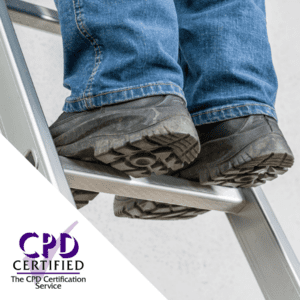Article 3 of 7. There are multiple styles of ladders for different tasks. However, each variant is designed for something different, has differing mechanisms, safety features and dangers if not used according to the manufacturer’s instructions. Below are types of ladders with pictures and how to use them safely
Ladder Safety Guidelines Article index
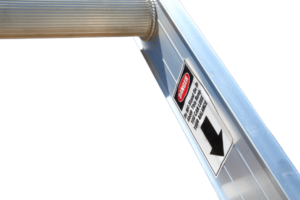
Leaning ladders.
When using a leaning ladder to carry out a task observe the following:
- Only carry light materials and tools – read the manufacturer’s labels on the ladder and assess the risks.
- Don’t overreach – make sure your belt buckle (or navel) stays within the stiles.
- Make sure the ladder is long enough or high enough for the task.
- Don’t overload the ladder – consider your weight and the equipment or materials you are carrying before working at height.
- Check the pictogram or label on the ladder for any advisory information.
- To help make sure the ladder angle is at the safest position to work from- you should use the 1-in-4 rule. This is where the ladder should be one space or unit of measurement out for every four spaces or units up (a 75° angle).
- Always grip the ladder and face the ladder rungs while climbing or descending – don’t slide down the stiles.
- Don’t try to move or extend the ladder while standing on the rungs.
- Don’t work off the top three rungs. Try to make sure that the ladder extends at least 1 metre or three rungs above where you are working.
- Don’t stand ladders on movable objects, such as pallets, bricks, lift trucks, tower scaffolds, excavator buckets, vans or mobile elevating work platforms.
- Avoid holding items when climbing (consider using a tool belt).
- Don’t work within 6 m horizontally of any overhead power line, unless it has been made dead or it is protected with insulation. Use a non-conductive ladder (eg fibreglass or timber) for any electrical work.
- Maintain three points of contact when climbing and wherever possible at the work position.
- Where you cannot maintain a handhold, other than for a brief period (eg to hold a nail while starting to knock it in, start a screw etc), you will need to take other measures to prevent a fall or mitigate the consequences if one happened.
- Secure the ladder (eg by tying the ladder to prevent it from slipping either outwards or sideways) and have a strong upper resting point (i.e. do not rest it against weak upper surfaces such as glazing or plastic gutters).
- Consider using an effective stability device (a device which, if used correctly, prevents the ladder from slipping, some types of ladders come with these).
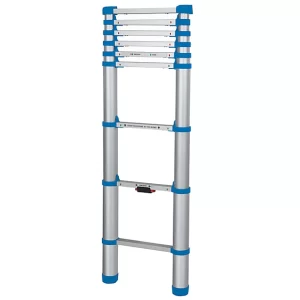
Telescopic ladders.
Telescopic ladders are a variation of leaning ladders but remember that they don’t all work in the same way.
They should always be used, stored and transported with care and kept clean. In addition to following this guidance, it’s important you read and follow the user instructions provided by the manufacturer.
Before every use – in addition to the normal ladder checks – make sure they are operating correctly and that the mechanisms that lock each section are working properly.
Always follow the user instructions regarding the opening and closing procedure. Be aware of the potential for trapping fingers between the closing sections. Remember some of the important parts are inside where they cannot be seen. If you are in any doubt, do not use them.
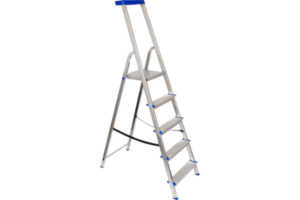
Stepladders.
Stepladders are very handy and have a wide range of uses, but remember the following when using a stepladder to complete a task.
- Check all four stepladder feet are in contact with the ground and the steps are level.
- Only carry light materials and tools.
- Don’t overreach.
- Don’t stand and work on the top three steps (including a step forming the very top of the stepladder) unless there is a suitable handhold.
- Ensure any locking devices are engaged.
- Try to position the stepladder to face the work activity and not side on. However, there are occasions when a risk assessment may show it is safer to work side on, for example in a retail stock room when you can’t engage the stepladder locks to work face on due to space restraints or narrow aisles, but you can fully lock it to work side on.
- Try to avoid work that imposes a side loading, such as side-on drilling through solid materials (eg bricks or concrete).
- Where side loadings cannot be avoided, you should prevent the steps from tipping over, by tying the steps, or some other method of securing. Otherwise, use a more suitable type of access equipment.
- Maintain three points of contact at the working position. This means two feet and one hand, or when both hands need to be free for a brief period, two feet and the body supported by the stepladder.
When deciding whether it is safe to carry out a particular task on a stepladder where you cannot maintain a handhold (eg to put a box on a shelf, hang wallpaper, or install a smoke detector on a ceiling), the decision needs to be justified, taking into account:
- The height of the task.
- Whether a handhold is still available to steady yourself before and after the task.
- Whether it is light work.
- Whether it avoids side loading.
- Whether it avoids overreaching.
- Whether the stepladder can be tied (eg when side-on working).
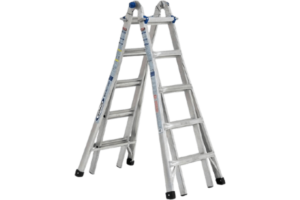
Combination and multi-purpose ladders.
Combination and multi-purpose ladders can be used as stepladders, a variation of stepladders or leaning ladders. Combination ladders are sometimes referred to as ‘A’ frame ladders.
These types of ladders can be used in a variety of different configurations. You should:
- Check to ensure that any locking mechanism is properly engaged before use.
- Always recheck the locking mechanism if the setup of the ladder is changed.
- On three-part combination ladders, never extend the top section (the section extending above the A frame) beyond the limit marked on the ladder and specified in the user manual.
Safe Use of Ladders and Stepladders –
Online Safety Training.
NEXT> Ladder safety guidelines – where ladders should be used
Source: https://www.hse.gov.uk/work-at-height/ladders/when-how-to-use-ladders-safely.htm

